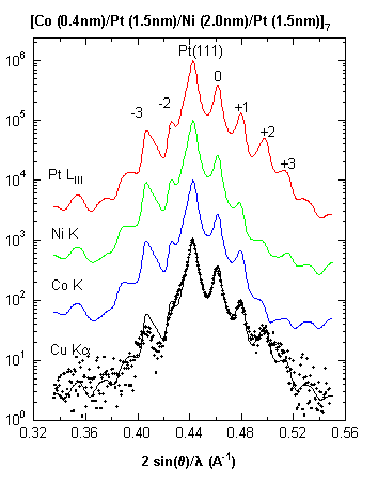
CHARACTERIZATION OF THE REAL STRUCTURE OF ULTRA-THIN MAGNETIC MULTILAYERS USING X-RAY REFLECTIVITY, X-RAY DIFFRACTION AND DAFS METHODS
J. Vacínová, D. Rafaja, V. Valvoda
Faculty of
Mathematics and Physics, Charles University, Prague, Czech
Republic
The multilayer systems based on the alternation of the cobalt and nickel layers and the platinum or gold layers are investigated intensively due to their interesting novel magnetic and magneto-optic properties. Giant magnetoresistance, surface magnetic anisotropy and Kerr rotation are the most frequently reported effects [1-3]. From the structural point of view these magnetic and magneto-optic properties are strongly influenced by a composition of individual layers, their thickness and the quality of interfaces.

Our contribution is devoted to the investigation of ultra-thin multilayer systems Co/Ni and Co/Pt/Ni/Pt prepared by electron beam deposition. The systems were characterized by the X-ray reflectivity and X-ray diffraction measurements which yielded an information on the thickness and interface roughness of individual layers, the interplanar spacing and the continuous and intralayer roughness [4]. As cobalt and nickel exhibit complete solid solubility in the cubic (a-Co,Ni) phase [5], a very high degree of interdiffusion was assumed in the Co/Ni system. This hypothesis was partially verified by X-ray reflectivity and diffraction measurements using the CuKa radiation.
On the contrary to the Co/Ni system, the amount of interdiffusion in the Co/Pt/Ni/Pt system was believed to be lower as the phase diagrams of Co-Pt and Ni-Pt contain ordered phases. The diffraction patterns collected using the CuKa radiation around the Pt(111) diffraction peak showed several well pronounced satellites peaks verifying the ordered superlattice (Fig.1, Data fitting and simulation of diffracted intensities in the vicinity of CoK, NiK and Pt LIII absorption edges). However, to obtain a good fit to diffraction data we have to suppose a certain quantity of interdiffusion different for Co and Ni elements in the structural model [4].
As the Co and Ni are the
neighboring elements in the periodic table we can obtain an
unambiguous answer on the diffusion process of these two elements
only when enhancing the difference of their scattering powders in
the vicinity of the Co or Ni K absorption edges. The preliminary
calculations of diffraction patterns for distinct wavelengths in
the vicinity of these absorption edges have shown a strong
enhancement in intensity of satellite peaks which are nearly not
observable for the CuKa radiation. Using the Diffraction
Anomalous Fine Structure technique, which is a powerful tool to
extract the selective spectroscopic information of
atoms-absorbers even at interfaces [6], we propose to clarify the
interdiffusion phenomena of Co and Ni magnetic atoms in distinct
multilayer systems.